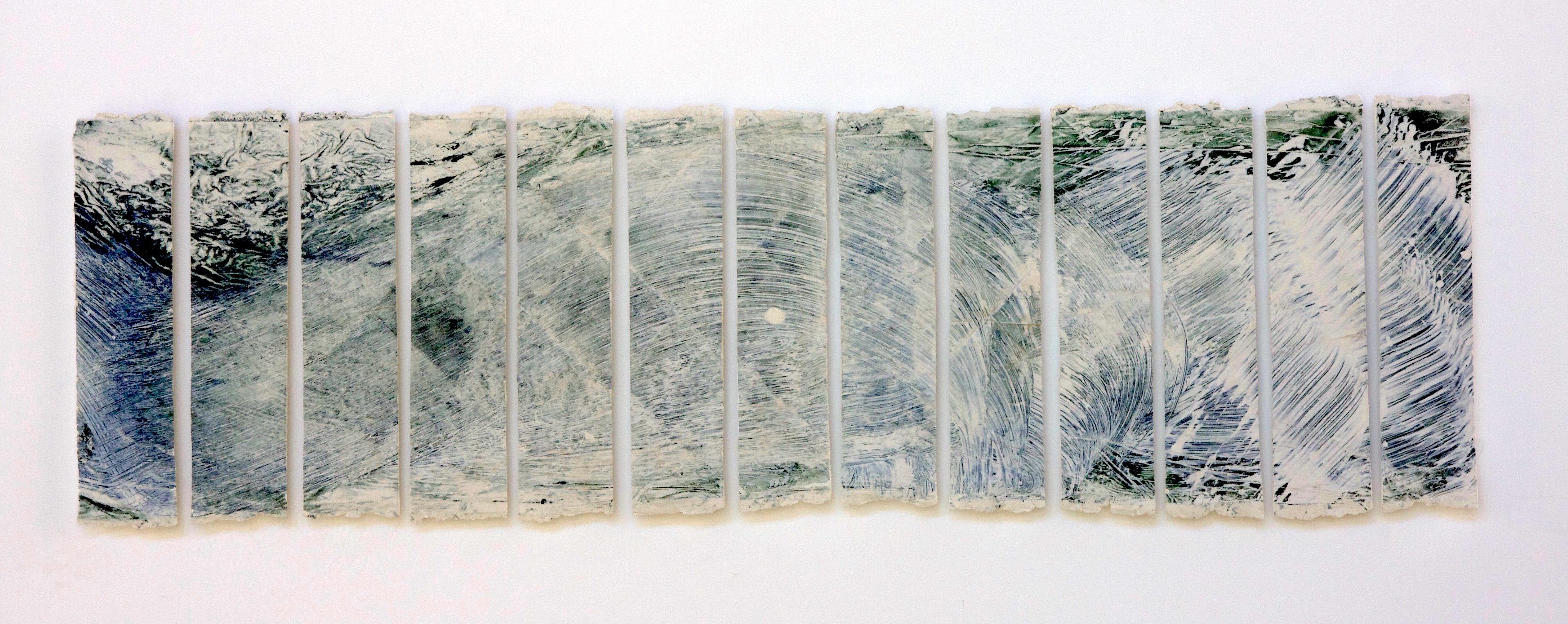
12 minute read
DISSEMINATION
from GALPIN_01
by UWUoA322021
Exhibitions, Conferences, Writing, Research Groups
Pippa Galpin: Blue Triptych, (2017) Shown at The International Ceramics Festival Aberystwyth University. July 2017 Height 56cm, width 142 cm, depth 4cm.
Advertisement
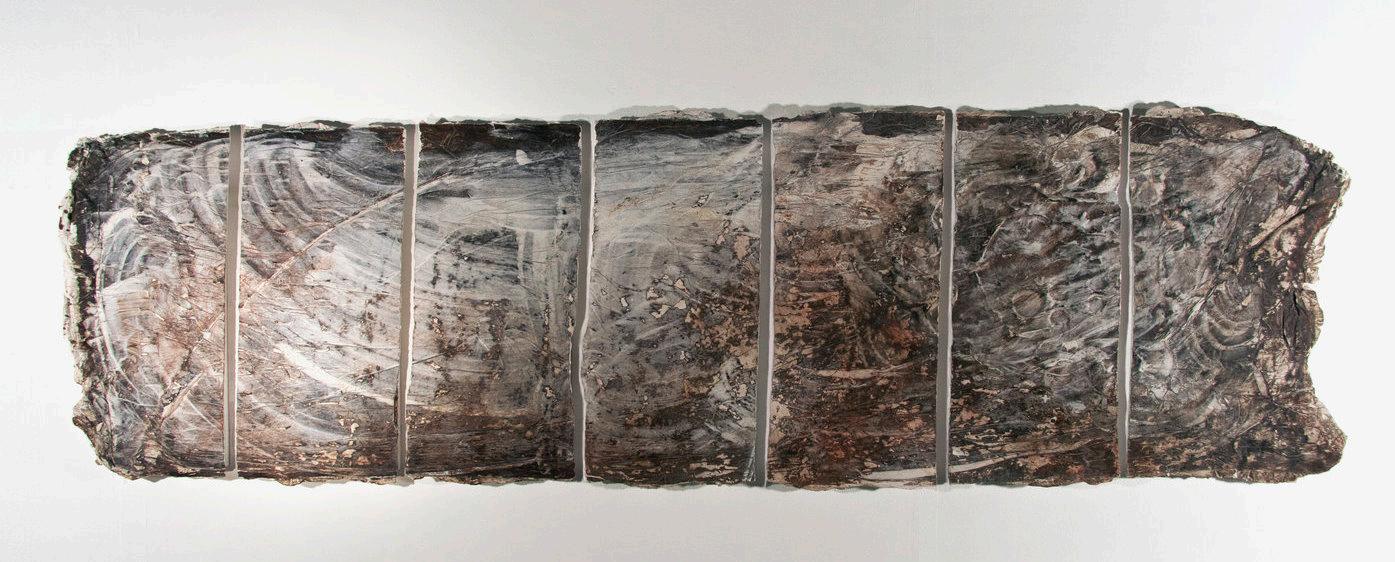
Pippa Galpin : ‘Opening a door’
Taken from the crypt of Worcester Cathedral. Exhibited IMPACT 10 Encounter, 2018 ‘Other Disciplines’ Exhibition Central Hall, Biblioteca Central de Cantabria. Santander 7-piece ceramic frieze, height 54cm, width 146cm.
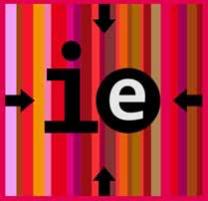
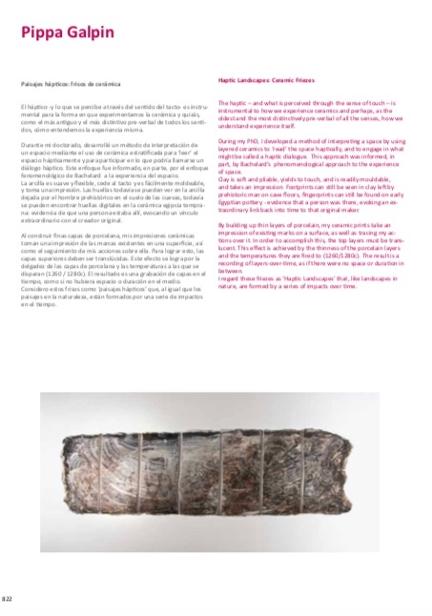
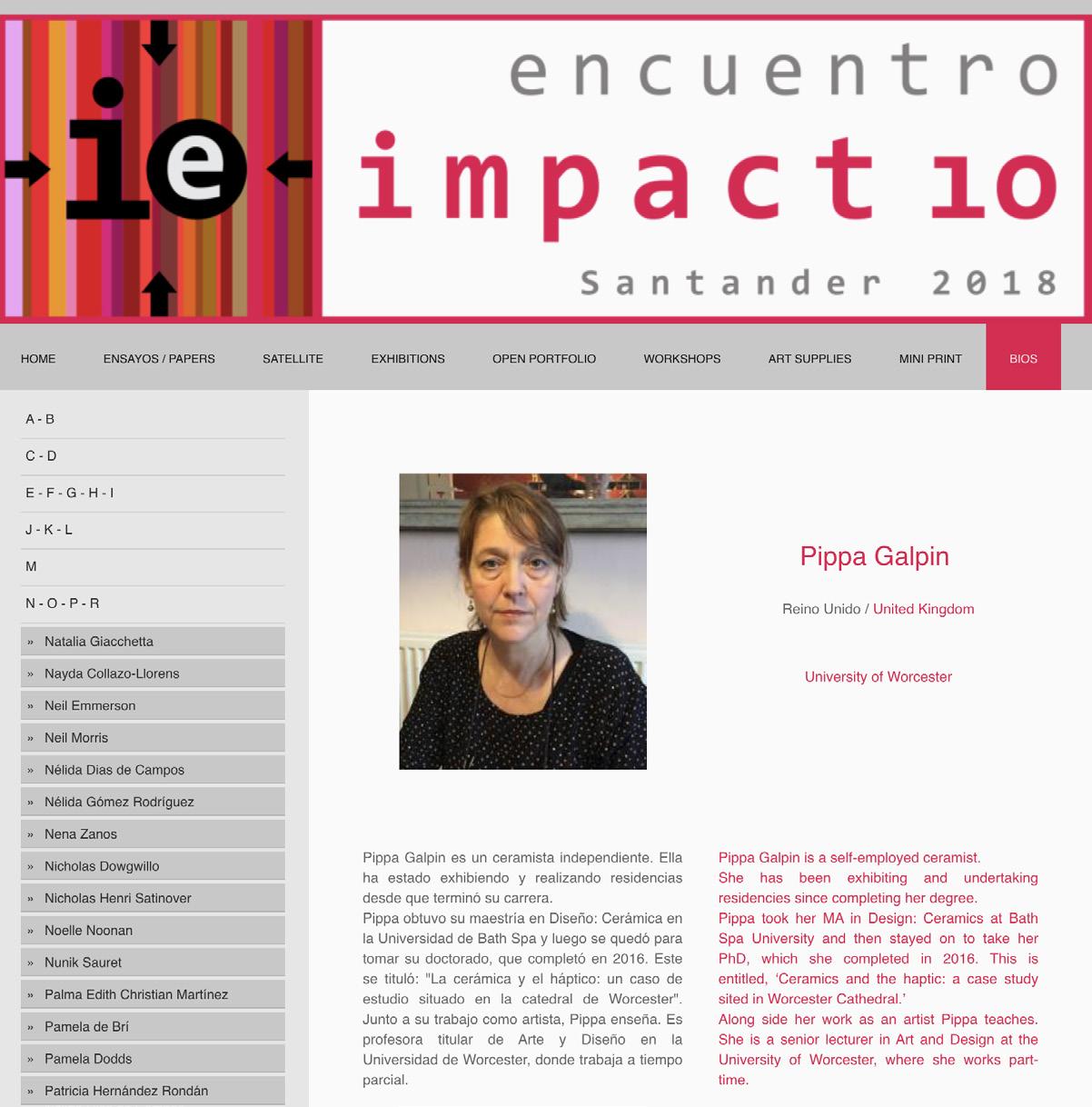
Encuentro y Conferencia Internacional Multidisciplinar de Gráfica / Encounter & International Multidisciplinary Printmaking Conference
Pippa Galpin
Catalogue text
ISBN: 978-84-09-07801-1 Date of publication: 17-12-2018 www.impact10.es/open-portfolio
Paisajes hápticos: frisos de cerámica
El háptico -y lo que se percibe a través del sentido del tacto- es instru- mental para la forma en que experimentamos la cerámica y quizás, como el más antiguo y el más distintivo pre-verbal de todos los senti- dos, cómo entendemos la experiencia misma. Durante mi doctorado, desarrollé un método de interpretación de un espacio mediante el uso de cerámica estratificada para ‘leer’ el espacio hápticamente y para participar en lo que podría llamarse un diálogo háptico. Este enfoque fue informado, en parte, por el enfoque fenomenológico de Bachelard a la experiencia del espacio. La arcilla es suave y flexible, cede al tacto y es fácilmente moldeable, y toma una impresión. Las huellas todavía se pueden ver en la arcilla dejada por el hombre prehistórico en el suelo de las cuevas, todavía se pueden encontrar huellas digitales en la cerámica egipcia tempra- na: evidencia de que una persona estaba allí, evocando un vínculo extraordinario con el creador original. Al construir finas capas de porcelana, mis impresiones cerámicas toman una impresión de las marcas existentes en una superficie, así como el seguimiento de mis acciones sobre ella. Para lograr esto, las capas superiores deben ser translúcidas. Este efecto se logra por la delgadez de las capas de porcelana y las temperaturas a las que se disparan (1260 / 1280c). El resultado es una grabación de capas en el tiempo, como si no hubiera espacio o duración en el medio. Considero estos frisos como ‘paisajes hápticos’ que, al igual que los paisajes en la naturaleza, están formados por una serie de impactos en el tiempo.
Haptic Landscapes: Ceramic Friezes
The haptic – and what is perceived through the sense of touch – is instrumental to how we experience ceramics and perhaps, as the oldest and the most distinctively pre-verbal of all the senses, how we understand experience itself. During my PhD, I developed a method of interpreting a space by using layered ceramics to ‘read’ the space haptically, and to engage in what might be called a haptic dialogue. This approach was informed, in part, by Bachelard’s phenomenological approach to the experience of space. Clay is soft and pliable, yields to touch, and is readily mouldable, and takes an impression. Footprints can still be seen in clay left by prehistoric man on cave floors, fingerprints can still be found on early Egyptian pottery - evidence that a person was there, evoking an extraordinary link back into time to that original maker. By building up thin layers of porcelain, my ceramic prints take an impression of existing marks on a surface, as well as tracing my actions over it. In order to accomplish this, the top layers must be trans- lucent. This effect is achieved by the thinness of the porcelain layers and the temperatures they are fired to (1260/1280c). The result is a recording of layers-over-time, as if there were no space or duration in between. I regard these friezes as ‘Haptic Landscapes’ that, like landscapes in nature, are formed by a series of impacts over time.
https://www.impact10.es/# https://www.impact10.es/exhibitions/bcc-hall-central/#
https://www.impact10.es/bios/n-o-p-r/pippa-galpin/
Open Portfolio and Projects Exhibition Santander, Spain 2018 www.impact10.es/s/cc_images/cache_12639366.jpg
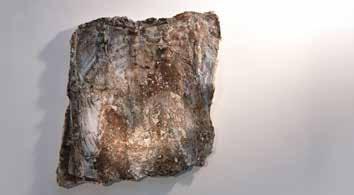
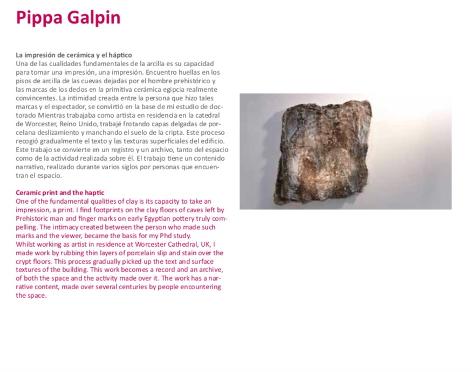
Ceramic panel Exhibited at ‘Open Projects’ Santander, Spain 2018 height 56cm, width 56cm The piece above depicts two people facing each other taken from a gravestone on the crypt floor.
Open Projects, Palacio de Exposiciones: La impresión de cerámica y el háptico
Una de las cualidades fundamentales de la arcilla es su capacidad para tomar una impresión, una impresión. Encuentro huellas en los pisos de arcilla de las cuevas dejadas por el hombre prehistórico y las marcas de los dedos en la primitiva cerámica egipcia realmente convincentes. La intimidad creada entre la persona que hizo tales marcas y el espectador, se convirtió en la base de mi estudio de doc- torado Mientras trabajaba como artista en residencia en la catedral de Worcester, Reino Unido, trabajé frotando capas delgadas de por- celana deslizamiento y manchando el suelo de la cripta. Este proceso recogió gradualmente el texto y las texturas superficiales del edificio. Este trabajo se convierte en un registro y un archivo, tanto del espacio como de la actividad realizada sobre él. El trabajo tiene un contenido narrativo, realizado durante varios siglos por personas que encuen- tran el espacio.
Ceramic print and the haptic
One of the fundamental qualities of clay is its capacity to take an impression, a print. I find footprints on the clay floors of caves left by Prehistoric man and finger marks on early Egyptian pottery truly compelling. The intimacy created between the person who made such marks and the viewer, became the basis for my Phd study. Whilst working as artist in residence at Worcester Cathedral, UK, I made work by rubbing thin layers of porcelain slip and stain over the crypt floors. This process gradually picked up the text and surface textures of the building. This work becomes a record and an archive, of both the space and the activity made over it. The work has a narrative content, made over several centuries by people encountering the space.
https://www.impact10.es/open-portfolio/#

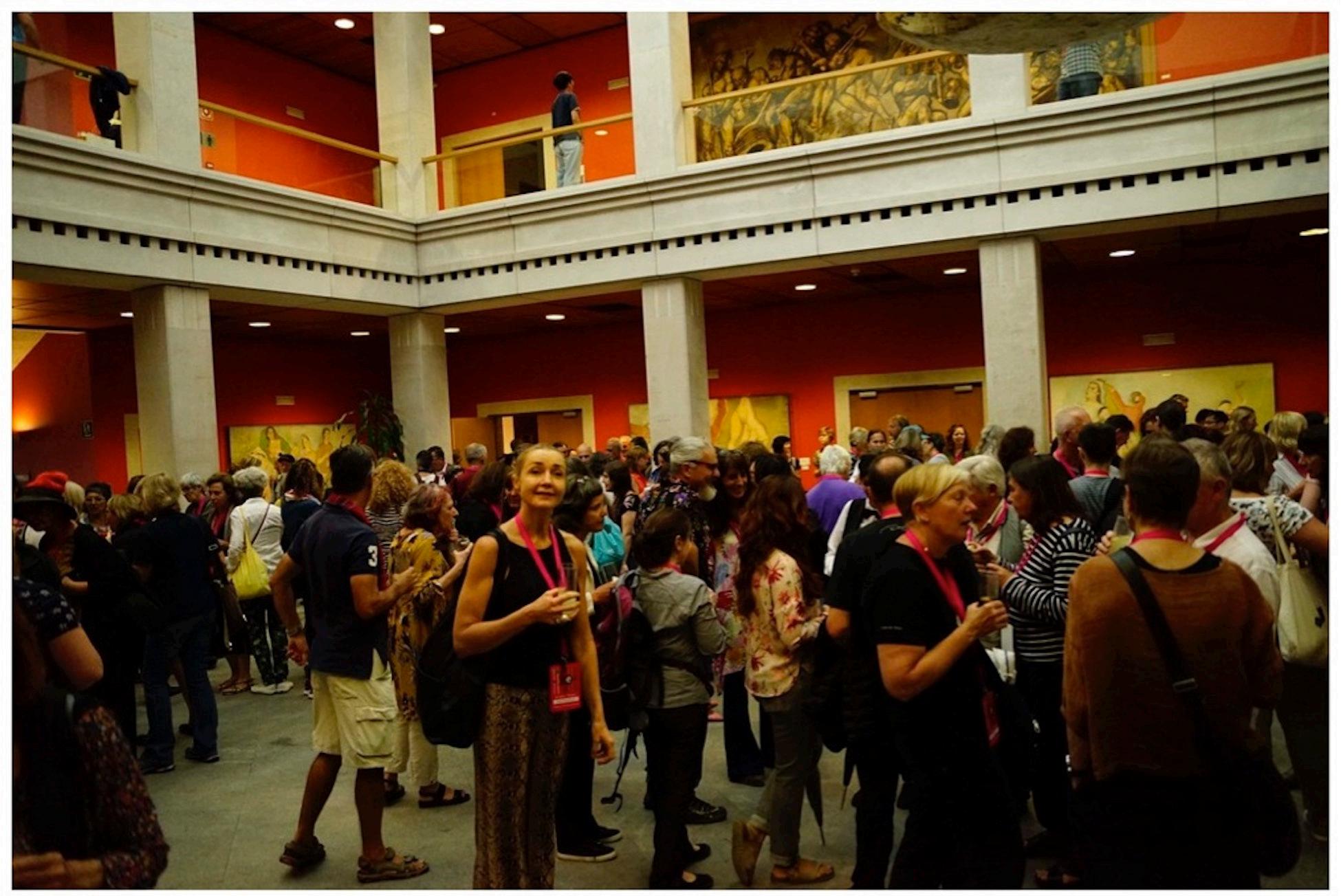

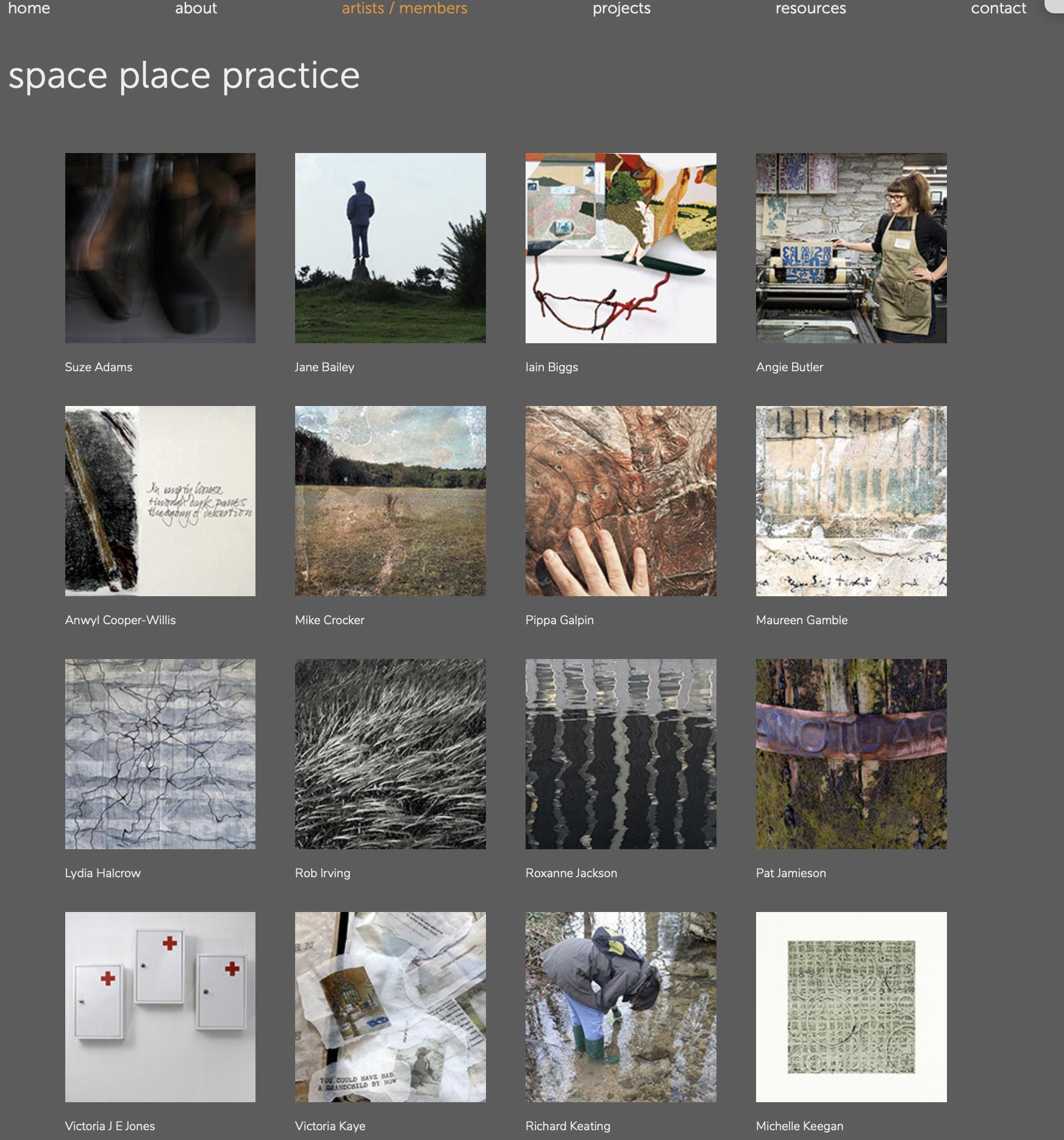
Space Place Practice is a research collective in which artists and multi-disciplinary researchers meet to engage with issues of space, place and site. Its dimensions are produced through interaction and critical discourse which act as points of departure for individual practice and collaborative projects. SPP takes the opportunity to exhibit together to explore the language of making and doing. Through these group projects we aim to expand on how we disseminate our ideas and experiences.
http://spaceplacepractice.com

Dr Pippa Galpin ( member 2015-current) Research interest: Exploration of the haptic.
The aims of SPP are to challenge and explore the interstices between embodied practice and theoretical enquiry where there is no hierarchical distinction between making, thinking, writing and doing. Our expanded practice is expressed in image, word and action.
The Museum Box Project: The Haptic Font-A Library of Pilgrimages

At its most basic, a haptic font – like the cuneiform font – is a natural stylisation of thought and being inherent in all human mark-making, encoded at the time and place of its impression. The process used for this collection involves placing clay between myself and the world around me. In this way, the resulting pieces become simultaneously a record of contact with a surface and the action made over it. As part of this collective, ‘Library of Pilgrimages’, these ceramic pieces are an archive of haptic fonts that can be said to have been felt into being. You are invited to hold the works – to place your hand in the artist’s space.
Space Place Practice Project: The Museum Box Project: Something of Place

Pippa Galpin:‘Museum Box Project: Something of Place’ Aberystwyth University School of Art Gallery, April-May 2015 ‘Museum Box Project- Something of Place’ and ‘Library of Pilgrimages’ Trowbridge Town Hall, Dec 2016 - Sept 2017.
This small ceramic sculpture was taken from a cast of part of a 14th century sarcophagus from the crypt of Worcester Cathedral. The elaborately carved stone figure that forms the lid is of a knight, lying on his back, with his feet resting on a small animal, possibly a lion. Placed in this museum archive box, although transformed, the ceramic piece retains something of the bodily about it, questioning a relationship between protection and confinement, a re-envisagement of the sense of being in the crypt.
WEBLINKS http://researchspace.bathspa.ac.uk/5760/2/MuseumBoxInvitation.pdf https://spaceplacepractice.wordpress.com/events/
Pippa Galpin: A Haptic Re-Enchantment of Place
Article to accompany the exhibition
I heard a story on the radio the other day. The speaker recalled a moment from her childhood. With what I expect were all my mirror neurons firing at once, this reactivated a memory of my own. Except this was a distinctively haptic memory:
The feel of Wellington boots, heavy and awkward on my legs; ice-cold water kept at bay; and the squelchy suck of mud that tried to grab the boots from my feet with each step...
Childhood is a place (“they do things differently there”). The recollection of it - especially in later life - is often magical. But the body is also a place. It may be thought of as the first place, followed by the womb, that we ever experience.
These first experiences are primarily haptic in nature.
The haptic – what is perceived through the sense of touch – is arguably the oldest and the most distinctively pre-verbal of all the senses. It may well be instrumental to how we experience the world and ourselves.
Yet despite this instrumentality, it leads to what I have called the paradox of the haptic. Firstly, we do not seem to have the words to adequately talk about it. As Rudolph Otto noted in respect of the ‘numinous’, we are consequently compelled to use metaphors to try to capture and signify the essence of what we feel. Crucial information about our tactile realities is often lost, or distorted, when put into words.
Secondly, the haptic fills the gaps in the stream of blended senses that are being constantly piped to the deepest, most ancient parts of our brain. Like salt in a meal, we only notice the haptic when it is violated: when there is too little or too much, or it’s missing altogether (pinching your nose when tasting something deletes the sense of smell from the ‘whole’ - normally blended - taste experience, and the experience suffers for it).
Thus, the haptic is the invisible sense without which nothing feels right.
If the body is a place, and indeed the first place, what would it mean to re-enchant it, or to find re-enchantments within it, much as we might find long-forgotten rooms in a mansion? The haptic becomes ‘visible’ when it changes. If you touch, or rub, a part of your body that isn’t often touched, you will become aware of it in a way you weren’t before. In Western cultures, we seldom touch the feet. Thus, foot massages (and some therapeutic interventions) pull up all kinds of forgotten sensations, memories, associations. They can make one person laugh and another weep. Once upon a time, feet were more important to us than they are now. We played with them as babies, sucked the toes on them, stumbled upon them with our first exploratory steps, squashed them into heel-pinching shoes, banged and bruised them as we learnt to ride our first bikes, and more. As we get older, and after decades of brutal shoe-imprisonment, walking barefoot on the grass can bring up sudden vivid feelings and memories, triggered by the haptic but also profoundly shaped by it.
If the body is a place, and the first place, then it is also where the oldest enchantments are buried.
The Museum in the Park, Stroud, 2019
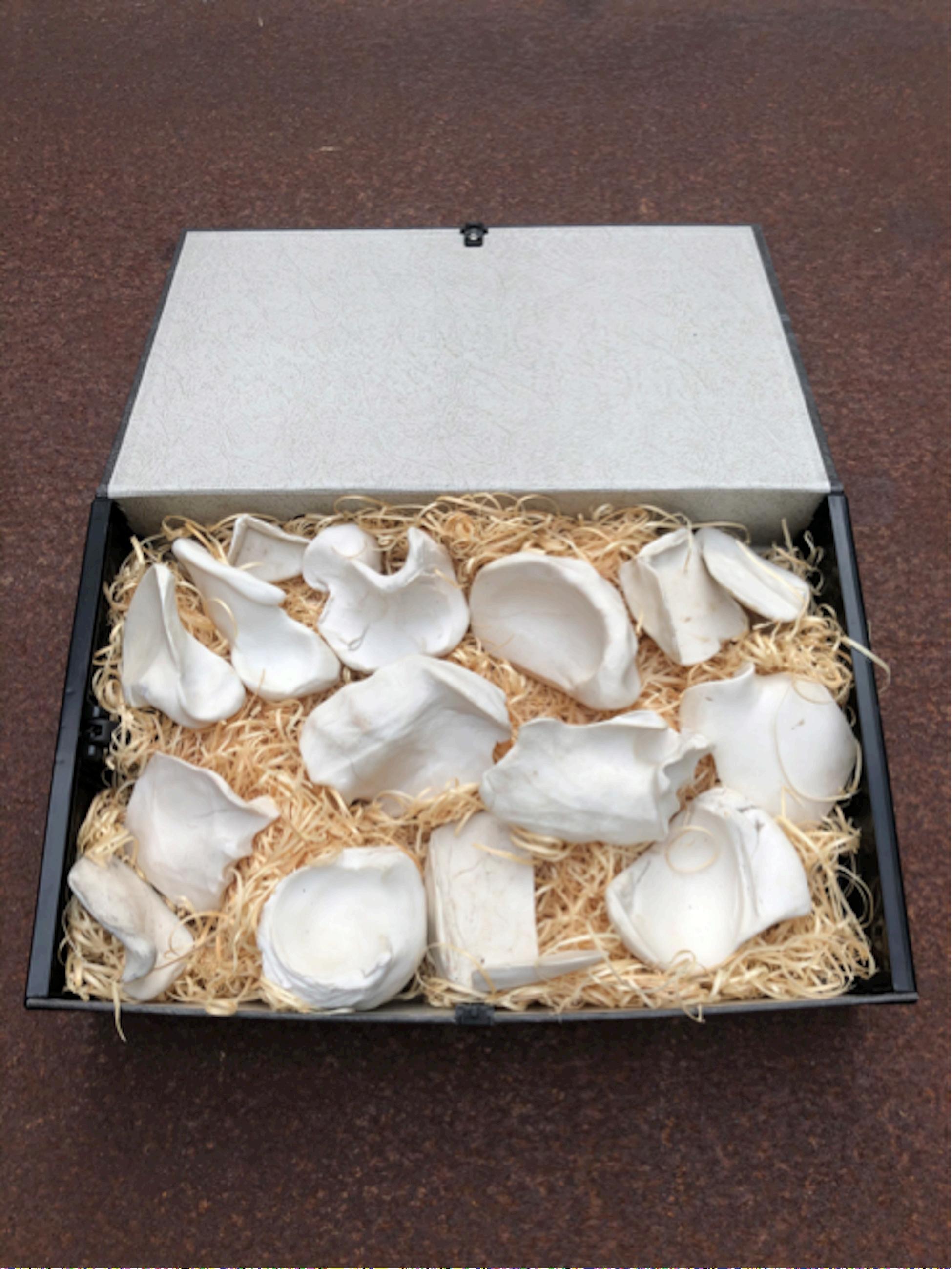
Pippa Galpin: A Haptic Re-Enchantment of Place (2019)
Physicality of expression evoked through direct contact is a primary purveyor of meaning for the crafts. By paring back elements specific to the ceramic genre, such as direct contact (for example holding a hand-made mug) and more recently even the eschewing the use of clay itself, the research during this period found that the language of ceramics and the haptic is transferable to new situations and even to different materials.
The ongoing work with Space Place Practice, whose research focus is on space, has developed the work from being necessarily about the exploration of a specific space, to becoming a perspective from which to think about the embodiment of space.
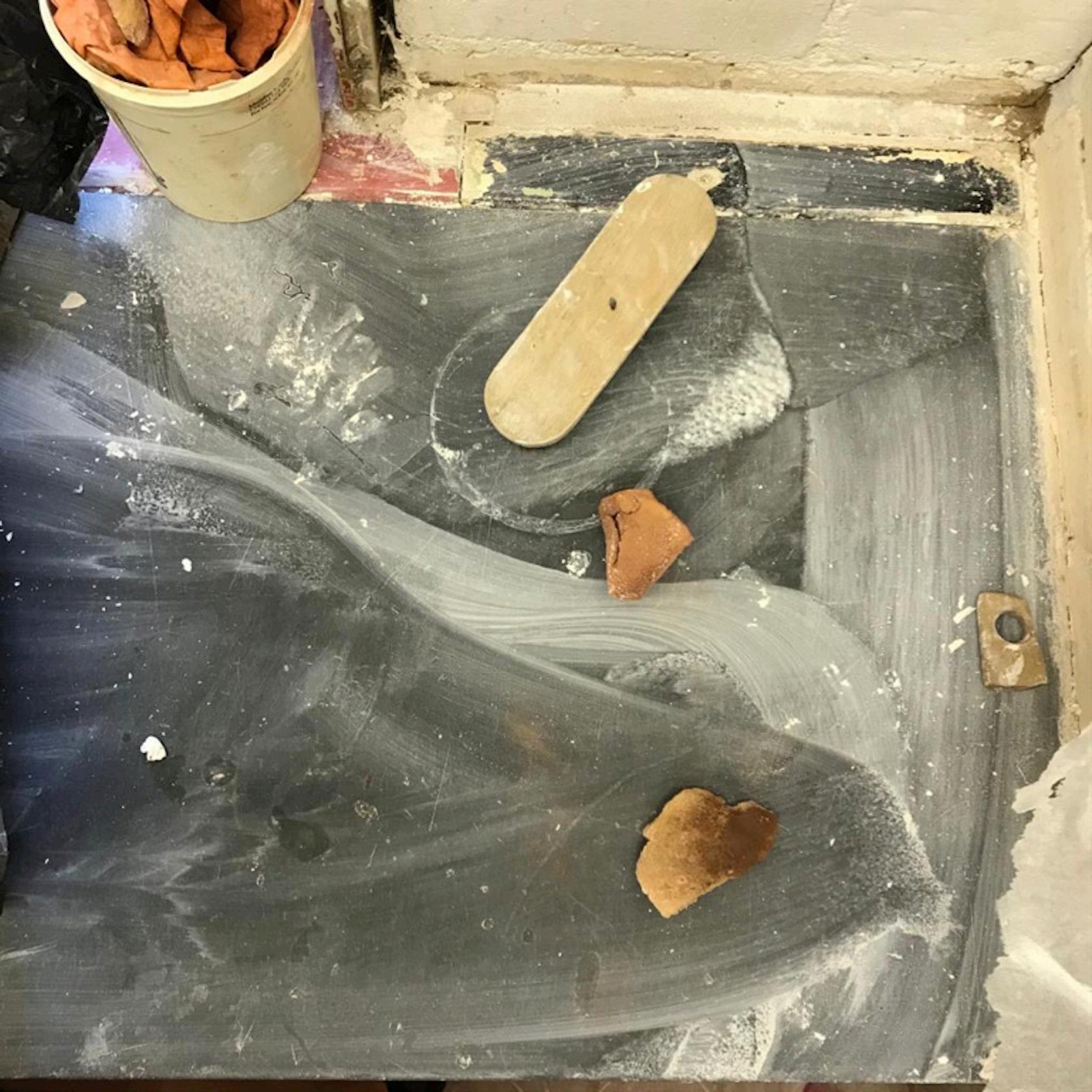
Pippa Galpin: Embodied Space- Home
Article for SPP Journal, Aug 2020
My pottery is the place where I make, either at the wheel, or on a slate top: preparing the clay, washing down the surface, watching the build-up and removal of marks, watching the making of the making, like observing the intricate unfolding of a story.
This making, unfolding, watching, all take place in a specific space, a narrowed space over-filled with shelves that jut, corners that bruise, with peaked and angled rafters, and two small windows that look down the garden to a pair of great conifers. Yet I rarely gaze from those windows. My work has become about the interaction with this space.
What is fundamental about the work now has been pared back to what Lakoff and Johnson describe as ‘the specifics of our everyday functioning in the world’. [1]
In these days, these lockdown days, I look forward to the process of throwing simple forms. The porcelain clay is uncomplicated, and as blank as the slate surface I work on.
Here I can leave myself behind, and as Philip Pullman said, “get out of the way of the story”.
‘Loss and Lucidity’ (The Lost & Found) is an exhibition of contemporary artwork investigating the misplaced, the missed and the mended.
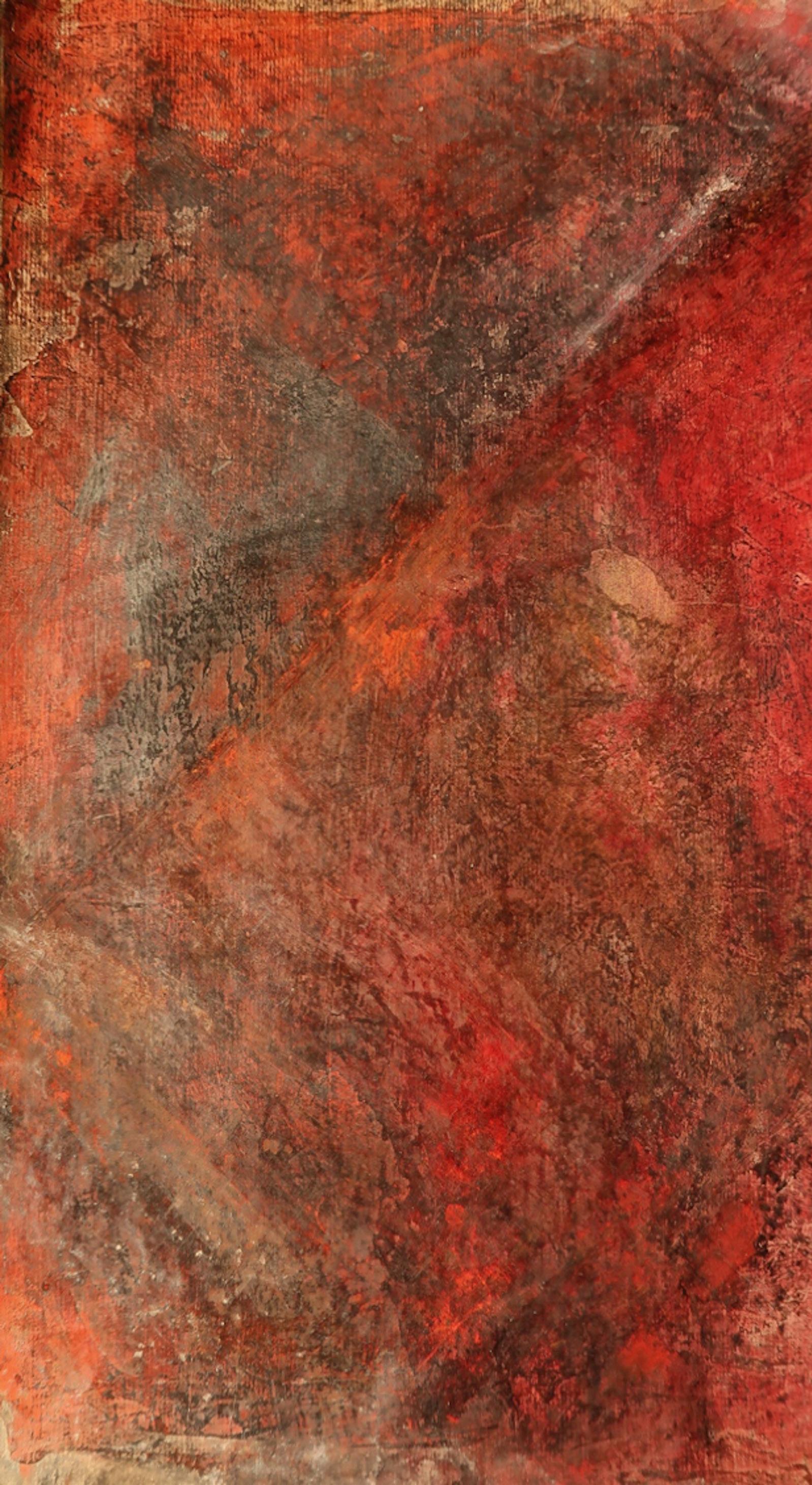
‘Floor Rubbings - Illuminating Secrets’ Exhibited at, Braco do Prata Factory, Lisbon, July-Sept 2019.
‘Red quarry tiles line my kitchen floor. Largely unseen and unremarked, they nevertheless hold a secret history: the haptic impact of movement over time, of the opposing forces of wear and accretion. From their rubbings a network of capillaries and chasms emerges, evoking all that has been forgotten.’
WEBLINKS http://losslucidity.blogspot.com/2018/06/aaron-oldenburg.html http://losslucidity.blogspot.com/search/label/Space%20Place%20Practice

